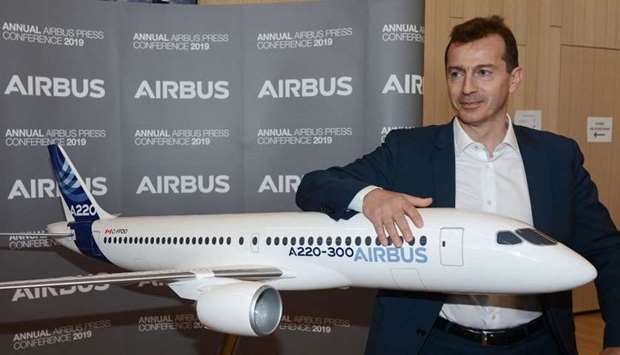* Airbus to bag close to 200 orders for new jet: sources
* Lufthansa profit warning highlights tougher times
* GE announces delay with engine for new Boeing 777X
Airbus launched a long-range version of its A321neo jet at the Paris Airshow on Monday, aiming to carve out new routes for airlines with smaller planes and steal a march on rival Boeing's plans for a possible new mid-market jet.
The European planemaker will announce close to 200 orders for the new model - the A321XLR - over the week, sources familiar with the matter told Reuters.
‘We can fly from north-eastern Asia into south Asia, from the Middle East to Bali or from Japan deep into Australia, and so on,’ said Airbus chief salesman Christian Scherer.
‘It is therefore the lowest-risk investment for airlines on these kinds of routes.’
Leasing company Air Lease Corp on Monday announced a deal for 100 Airbus planes, including 27 of the A321XLR jets, and sources familiar with the matter said Airbus was also close to announcing a deal with JetBlue Airways Corp.
The aerospace industry's biggest annual event, which alternates with Britain's Farnborough Airshow, is traditionally a slugging match between Airbus and Boeing sales teams in the $150 billion a year commercial aircraft market.
But analysts expect this year's show to be relatively subdued, with slowing economies, trade tensions and geopolitical uncertainty unsettling airlines, highlighted by a profit warning from Germany's Lufthansa late on Sunday.
Airbus and Boeing are also grappling with their own problems. The US planemaker is striving to bring its top-selling 737 MAX jet back into service after its grounding following two fatal crashes. Airbus, meanwhile, is occupied with a long-running corruption scandal.
Boeing boss Dennis Muilenburg on Sunday said he expected to announce orders for wide-body jets at the show but his main focus at the event was safety.
Analysts expect anything from 400 to 800 commercial aircraft orders and commitments at the gathering, compared with 959 at Farnborough last year, though it can be hard to identify truly new business against firmed-up commitments and switched models.
SIZE VS COMFORT
The Airbus A321XLR will be the longest-range narrow-body jetliner and arrives as airlines look to maximise the flexibility of more fuel-efficient, single-aisle aircraft.
Its range of up to 4,700 nautical miles - about 15% more than the previous A321LR - will leapfrog the out-of-production Boeing 757 and nudges it into the long-jump category occupied by more costly wide-body jets.
It also eats into a range category targeted by a possible mid-market twin-aisle jet - the NMA - under review by Boeing.
‘It does provide a very effective airplane for many of the same routes as the NMA, and it does so many years earlier,’ Air Lease CEO John Plueger said of the new Airbus jet.
But there is a debate over whether passengers will enjoy flying longer distances in medium-haul planes and at what price.
In particular, the rise of the single-aisle, long-distance jet involves revisiting years of industry marketing about the benefit of roomier cabins to counter jet lag on long trips.
Boeing's Muilenburg on Sunday said that the A321XLR would only ‘scratch an edge’ of the market segment targeted by the NMA.
Boeing is also battling to bring the world's largest twin-engined jet - the 777X - into service, hampered by problems with General Electric's new GE9X turbine engine.
GE Aviation on Monday said it had found unexpected wear in a part for the GE9X, forcing a delay of several months while it redesigns and tests the part.
Boeing commercial airplanes boss Kevin McAllister said he was ‘staying very close to the situation’ and it was premature to make any predictions on delays for the programme.
Boeing is targeting a 2020 entry into service, but Gulf airline Emirates has said it expects the first plane in June of that year.

